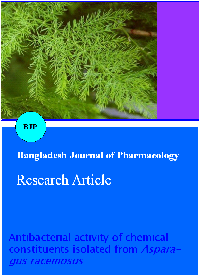Antibacterial activity of chemical constituents isolated from Asparagus racemosus
DOI:
https://doi.org/10.3329/bjp.v9i1.16672Keywords:
Antibacterial, Asparagus racemosus, E. coli, S. aureusAbstract
Asparagus racemosus is a medical extensively used in traditional medicine for various disorders including its use in infectious. So far work has been done to identify its active constituents responsible for antiseptic folk use of this plant. In the current investigation, we have made an effort to identify its chemical constituents that might be partly responsible for antimicrobial properties. Extraction and isolation of plant extract lead to isolation of two nor-lignans and two steroidal triterpenes (compound 1 to 4). All compound showed considerable antibacterial activities against E. coli and S. aureus while no significant activity was observed against S. typhi. This study highlighted the potential of A. racemosus to be further explored as a source of bioactive natural products.
Downloads
1090
472 Read
32
References
Battu GR, Kumar BM. Phytochemical and antimicrobial activity of leaf extract of Asparagus racemosus Willd. Pharmacognosy J. 2010; 2: 456-63.
Bhatnagar M, Sisodia SS, Bhatnagar R. Antiulcer and antioxidant activity of Asparagus racemosus WILLD and Withaniasomnifera DUNAL in rats. Ann New York Acad Sci. 2005; 1056: 261-78.
Diwanay S, Chitre D, Patwardhan B. Immunoprotection by botanical drugs in cancer chemotherapy. J Ethnopharmacol. 2004; 90: 49-55.
Hannan JM, Khatoon S, Rehana F, Jahan S, Rahman MM, Shelley SH. Antihyperglycaemic activity of Asparagus racemosus roots is partly mediated by inhibition of carbohydrate digestion and absorption, and enhancement of cellular insulin action. Br J Nutr. 2011; 6: 406-16.
Hannan JMA, Marenah L, Ali L, Rokeya B. Insulin secretory actions of extracts of Asparagus racemosus root in perfused pancreas, isolated islets and clonal pancreatic beta-cells. J Endocrinol. 2007; 192: 159-68.
Kanwar AS, Bhutani KK. Effects of Chlorophytum arundinaceum, Asparagus adscendens and Asparagus racemosus on pro-inflammatory cytokine and corticosterone levels produced by stress. Phytother Res. 2010; 24: 162-66.
Mandal SC, Nandy A, Pal M, Saha BP. Evaluation of antibacterial activity of Asparagus racemosus Willd. root. Phytother Res 2000; 14: 118-19.
Meena J, Ojha R, Muruganandam AV, Krishnamurthy S. Asparagus racemosus competitively inhibits in vitro the acetylcholine and monoamine metabolizing enzymes. Neurosci Lett. 2011; 503: 6-9.
Ojha R, Sahu AN, Muruganandam AV, Singh GK, Krishnamurthy S. Asparagus recemosus enhances memory and protects against amnesia in rodent models. Brain Cogn. 2010; 74: 1-9.
Oketch-Rabah HA, Dossaji SF, Christensen SB, Frydenvang K, Lemmich E, Cornett C, Olsen CE, Chen M, Kharazmi A, Theander T. Antiprotozoal compounds from Asparagus africanus. J Nat Prod. 1997; 60: 1017-22.
Patel LS, Patel RS. Antimicrobial Activity of Asparagus racemesus Wild From Leaf Extracts. Int J Sci Res Pub, 2013; 3: 1-3.
Ravishankar K, Kiranmayi GVN, Lalitha TM, Priyanka T, Ranjith T, Someswarao SBV, Raju VRK, Divya AV. Preliminary phytochemical screening and in vitro antibacterial activity on Asparagus racemosus root extract. Int J Pharm Chem Biol Sci. 2012; 2; 117-23.
Rege NN, Thatte UM, Dahanukar SA. Adaptogenic properties of six rasayana herbs used in Ayurvedic medicine. Phytother Res. 1999; 13: 275-91.
Sairam K, Priyambada S, Aryya NC, Goel RK. Gastroduodenal ulcer protective activity of Asparagus racemosus: An experimental, biochemical and histological study. J Ethnopharmacol. 2003; 86: 1-10.
Sharma S, Ramji S, Kumari S, Bapna JS. Randomized controlled trial of Asparagus racemosus (shatavari) as lactagogue in lactational inadequacy. Indian Paediatr. 1996; 33: 675-77.
Singh GK, Garabadu D, Muruganandam AV. Antidepressant activity of Asparagus racemosus in rodent models. Pharmacol Biochem Behav. 2009; 91; 283-90.
Visavadiya NP, Narasimhacharya RL. Hypolipidemic and antioxidant activities in Asparagus racemosus in hypercholes-teremic rats. Indian J Pharmacol. 2005; 37: 376-80.
Yang CX, Huang SS, Yang XP, Jia ZJ. Norlignans and steroidal saponins from Asparagus gobicus. Planta Med. 2004; 70: 446-51.
Zhang HJ, Sydara K, Tan GT, Ma C, Southavong B, SoejartoDD, Pezzuto JM, Fong HHS. Bioactive constituents from Asparagus cochinchinensis. J Nat Prod. 2004; 67: 194-200.

Published
How to Cite
Issue
Section
License
Authors who publish with this journal agree to the following terms:
- Authors retain copyright and grant the journal right of first publication with the work simultaneously licensed under a Creative Commons Attribution License that allows others to share the work with an acknowledgement of the work's authorship and initial publication in this journal.
- Authors are able to enter into separate, additional contractual arrangements for the non-exclusive distribution of the journal's published version of the work (e.g., post it to an institutional repository or publish it in a book), with an acknowledgement of its initial publication in this journal.
- Authors are permitted and encouraged to post their work online (e.g., in institutional repositories or on their website) prior to and during the submission process, as it can lead to productive exchanges, as well as earlier and greater citation of published work (See The Effect of Open Access).
